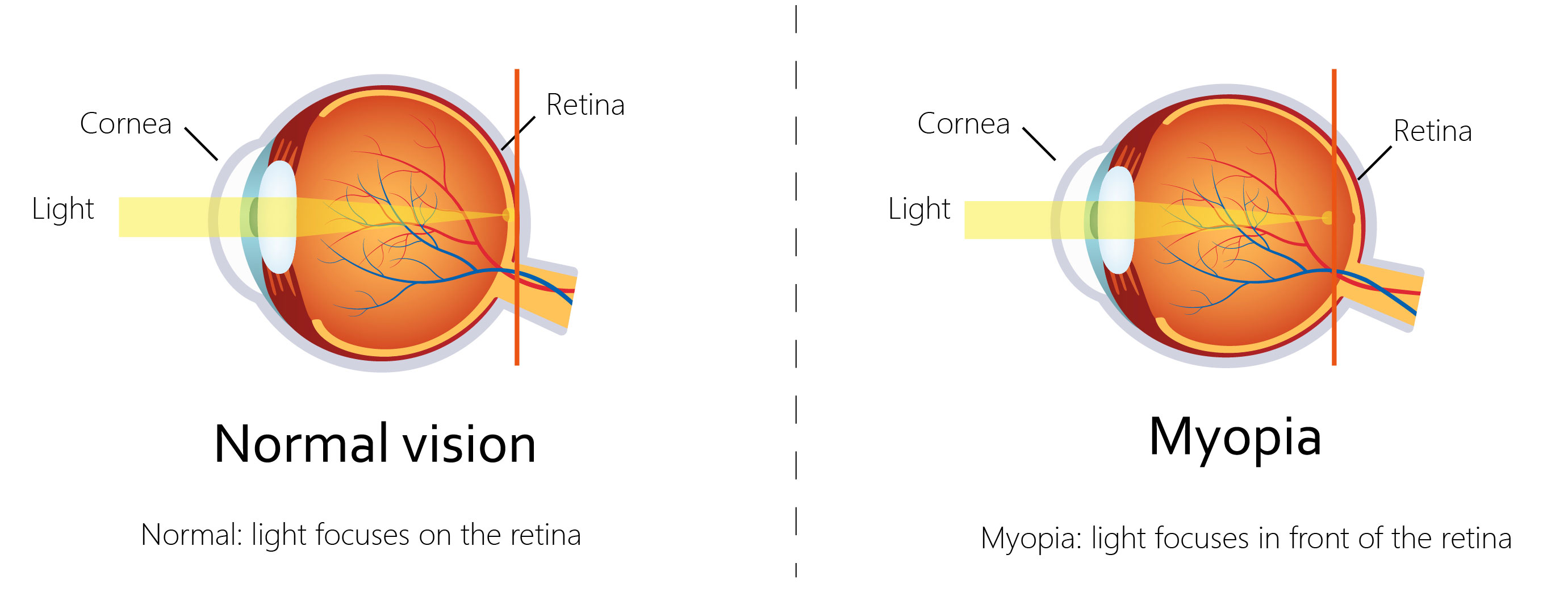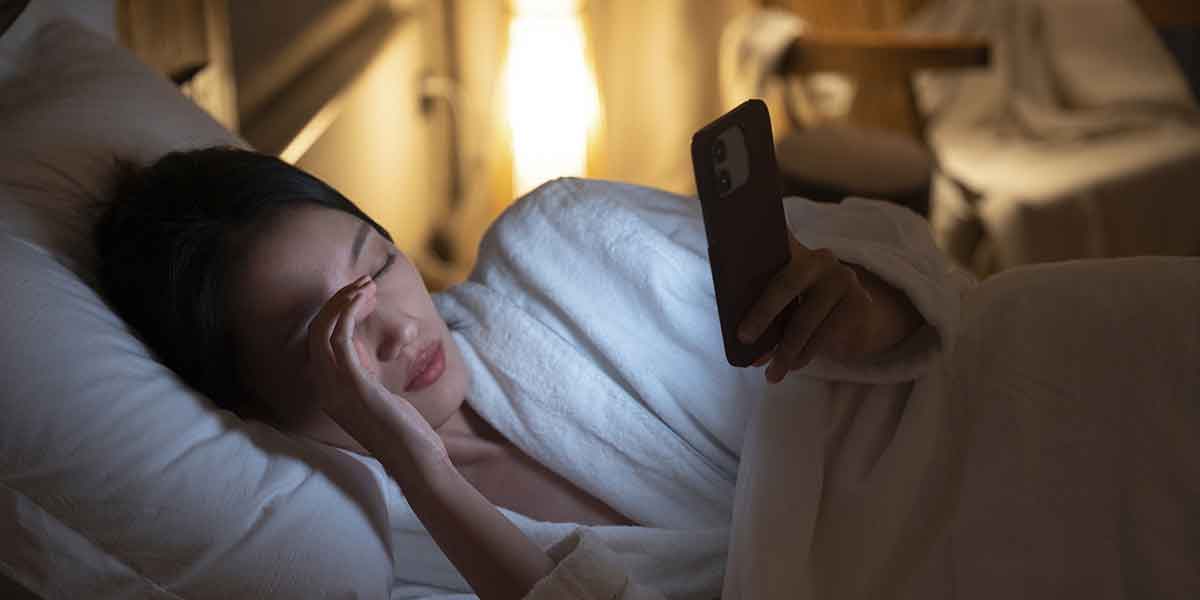Myopia, also referred to as nearsightedness, is a refractive vision condition characterized by blurred vision when viewing distant objects, while near vision remains clear. As one of the most prevalent visual impairments globally, myopia affects individuals across all age groups. Its incidence is rising, particularly among younger populations, making it increasingly important to understand its underlying causes, potential impacts, and effective prevention strategies.
1.What Is Myopia?
Myopia, commonly known as nearsightedness, is a refractive error in which the eyeball is elongated or the cornea is excessively curved. This anatomical variation causes incoming light to focus in front of the retina rather than directly on it, resulting in blurred vision for distant objects.
Myopia is typically categorized based on the degree of refractive error:
1)Low Myopia: A mild form of nearsightedness with a prescription of less than -3.00 diopters.
2)Moderate Myopia: A moderate level of myopia where the prescription ranges between -3.00 and -6.00 diopters.
3)High Myopia: A severe form of myopia with a prescription exceeding -6.00 diopters, often associated with an elevated risk of developing serious ocular complications such as retinal detachment, glaucoma, or myopic macular degeneration.

2.Causes of Myopia
Myopia is a multifactorial condition influenced by genetic predisposition, environmental exposures, and lifestyle behaviors. The key contributing factors are outlined below:
Genetic Factors
A familial history of myopia significantly increases an individual’s likelihood of developing the condition. Children with one or both parents affected by myopia have a notably higher risk of experiencing this refractive error, underscoring the strong hereditary component of the disorder.
Environmental Factors
1)Prolonged Near Work: Sustained engagement in activities requiring close visual focus, such as reading, writing, or the prolonged use of digital devices, imposes considerable strain on the eyes and has been identified as a key environmental risk factor for myopia.
2)Insufficient Outdoor Exposure: Limited time spent outdoors, particularly in environments with adequate natural light, has been strongly correlated with the increasing prevalence of myopia, especially in pediatric populations. Natural light exposure is believed to play a protective role in regulating ocular growth and preventing excessive axial elongation.
Lifestyle Habits
Modern lifestyles characterized by prolonged screen exposure, reduced physical activity, and minimal time spent outdoors are substantial contributors to the development and progression of myopia. These behaviors exacerbate visual stress and promote unfavorable conditions for maintaining optimal eye health.
3.Symptoms of Myopia
The clinical manifestations of myopia typically include:
1)Blurred Vision at a Distance: Difficulty in seeing objects clearly at far distances while near vision remains unaffected.
2)Frequent Squinting or Eye Strain: A tendency to squint in an effort to improve focus on distant objects, or experiencing eye fatigue from prolonged visual tasks.
3)Headaches: Often caused by the strain associated with focusing on distant objects for extended periods.
4)Increased Proximity to Visual Tasks: A need to sit closer to the television or hold reading materials at a reduced distance to see clearly.
If you or your child experience any of these symptoms, it is essential to seek a comprehensive eye examination from a qualified eye care professional for accurate diagnosis and appropriate corrective measures.
4.Impact of Myopia
Myopia can significantly affect quality of life, particularly when uncorrected. Beyond the inconvenience of blurred vision, high myopia can lead to serious eye health issues, including:
1)Retinal Detachment: The retina may pull away from the back of the eye, causing vision loss if not treated promptly.
2)Glaucoma: High eye pressure in myopic eyes increases the risk of optic nerve damage.
3)Myopic Macular Degeneration: Prolonged stretching of the retina can lead to macular damage and vision impairment.
5.Preventing and Managing Myopia
Although genetic predisposition to myopia cannot be modified, various evidence-based strategies can help prevent its onset or slow its progression. These approaches focus on lifestyle modifications, environmental adjustments, and early detection:
1)Increase Time Spent Outdoors
Research suggests that exposure to natural light plays a significant protective role against the development and progression of myopia. Encouraging children to spend at least two hours per day outdoors can help regulate ocular growth and reduce myopia risk.
2)Adopt the 20-20-20 Ruler
To minimize eye strain from prolonged near work, implement the 20-20-20 rule: every 20 minutes, take a 20-second break to focus on an object at least 20 feet away. This simple practice helps relax the ciliarymuscles and prevents over-accommodation.
3)Limit Screen Time
Excessive use of digital devices, especially in children, is strongly associated with myopia progression. Encourage alternative activities, such as outdoor sports, hobbies, or exploration of nature, to reduce reliance on close-focus tasks.
4)Optimize Lighting Conditions
Ensure that all visual tasks, including reading, writing, and screen use, are performed in well-lit environments. Proper lighting reduces unnecessary visual strain and promotes better eye health.
5)Schedule Regular Eye Examinations
Routine comprehensive eye examinations are critical for early detection and timely intervention in managing myopia. Regular check-ups are especially important for children and individuals with a family history of myopia, enabling appropriate corrective measures and monitoring of progression.


6.Myopia in the Digital Age
The rise of digital devices has brought convenience to our lives but also contributed to the increase in myopia cases globally. Known as "digital eye strain" or "computer vision syndrome," extended screen use can exacerbate nearsightedness symptoms.
Strategies for Reducing Digital Eye Strain
To mitigate the adverse effects of prolonged screen use and reduce the risk of myopia progression, the following practices are recommended:
1)Optimize Screen Brightness: Adjust the brightness of digital screens to match the ambient lighting in the room. This minimizes glare and prevents eye strain caused by excessive contrast.
2)Maintain Proper Viewing Distance: Ensure that screens are positioned at an appropriate distance, typically around an arm's length, to reduce ocular strain. Additionally, the screen should be positioned slightly below eye level to encourage a natural line of sight.
3)Practice Regular Blinking: Frequent blinking is essential to keep the eyes moist and reduce dryness associated with extended screen use. Try to blink consciously and regularly to promote healthy tear film production.
By incorporating these preventive measures into daily routines, individuals can significantly reduce the impact of digital eye strain and help protect their eyes from the exacerbating effects of extended screen exposure.
7.Conclusion
Myopia is a growing global concern, but with the right knowledge and proactive measures, it can be managed effectively. Whether through lifestyle changes, corrective lenses, or advanced treatment options, maintaining healthy vision is within reach.
At IDEAL OPTICAL, we are more than just a lens provider—we are your partner in eye care. Contact us today to explore our range of myopia solutions and take the first step toward better vision for you and your family.
Post time: Dec-18-2024





